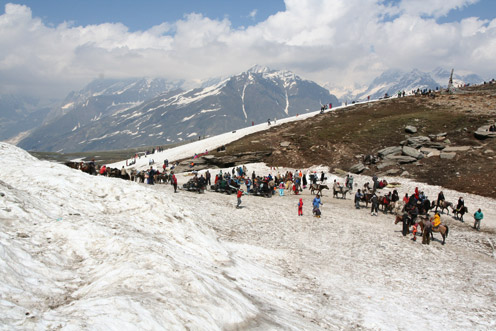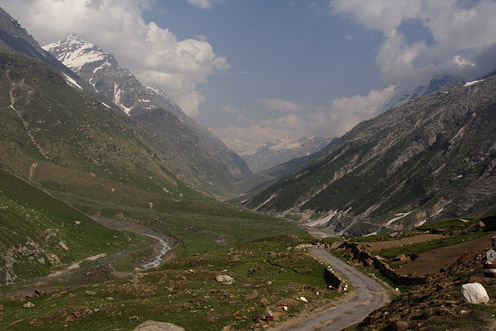A good friend and an expert of Himalayas, Manish Lakhani is planning a bicycling tour from Leh to Manali next month. He is looking for a handful of people to join him on the tour. Below are the tour details. If you would be interested, reach him for more details at manisholiday@gmail.com
Tour Details
This bicycle ride takes you through one of the most difficult and remote but picturesque terrain that you can ever access by road anywhere in India. It is amazing to see how Indian Army (BRO – Border Road Organization) builds and manages roads in this stark and remote terrain. The ride takes you to magnificent scenery over a series of 5000m+ passes, starting from lush green Kullu Valley over to high altitude deserts and stark mountains Ladakh.
Join us for one of the most challenging and wonderful bike ride on this planet.
Dates – 1 June to 10 June 2012.
Start – Manali
Finish – Leh
Altitude – Start 2050m (Manali) / max 5350m (Taglang La) / end 3505m (Leh)
Accommodation & Support Level – Full Camping services, Jeep backup and support.
Distance – About 500 Kms.
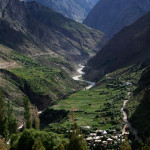
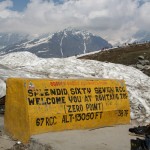
Detailed Itinerary
| Day |
Cycle |
Distance Km |
Altitude Ascending descending (m) |
Camping Height (m) |
| 1 |
Manali-Marhi |
37.5 km |
1,270 m |
3,312 m |
| 2 |
Marhi-Sissu |
53.4 km |
666 m |
3,120 m |
| 3 |
Sissu-Keylong |
31.5 km |
396 m |
3,350 m |
| 4 |
Keylong-Patseo |
47.6 km |
611 m |
3,811 m |
| 5 |
Patseo-Sarchu |
65.3 km |
1,080 m |
4,253 m |
| 6 |
Sarchu-Whisky Nullah |
51.0 km |
457 m |
4,700 m |
| 7 |
Whisky Nullah-Pang |
29.8 km |
370 m |
4,530 m |
| 8 |
Pang-Moray Plains |
53.1 km |
300 m |
4.700 m |
| 9 |
Moray Plains-Upshi |
79.2 km |
666 m |
3,600 m |
| 10 |
Upshi-Leh |
68.4 km* |
300 m* |
3,500 m |
People start from Manali at an unearthly hour of 2am. And they keep going and going and going, travelling nearly twenty hours to get to Leh. It seems like a senseless adventure to go in a cramped Tata Sumo in those testing altitudes; It seems like Leh will never come. But people do it: many Sumos leave for Leh everyday, packing passengers from Manali who don’t want to waste a day or spend more money by stopping on the way.
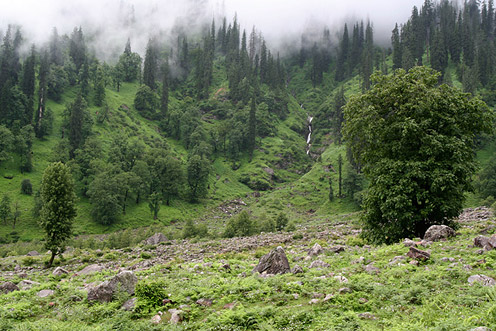
Verdant landscapes of Beas Valley
The initial part of the journey is pleasant. The road runs upstream of Beas River through a green valley, with tall mountains on both sides flaunting coniferous forests on their slopes. It slopes up gently for the first half hour and then steadily increases in gradient. Waterfalls run abundant on the near vertical slopes, emerging out of the snow trapped in depressions. The sheer scale of mountains in these parts are realized by tiny specs of shepherd-tents that look no bigger than a small dot on the slopes. It indeed needs no less than a collision between two continental masses to create formations of this scale and might. Its grandeur, size and fearsome weather can overwhelms the onlooker and instantly earn his or her respect.
The slopes of Manali-Rohtang Pass road remain green through the year in lower regions. The deodar forests give way to shorter vegetation higher up, and eventually it is just green grass spreading thinly on the surface. Streams run all over the place uncontrolled, released from the melting masses of ice. The pass is completely covered in snow in early summer and gradually melts away, with very little of it left when the monsoons arrive. As the first rains come in and snow is drained out from the higher regions, flowers burst out on the slopes, filling up every inch of the mountains with tiny dots of pink and yellow.
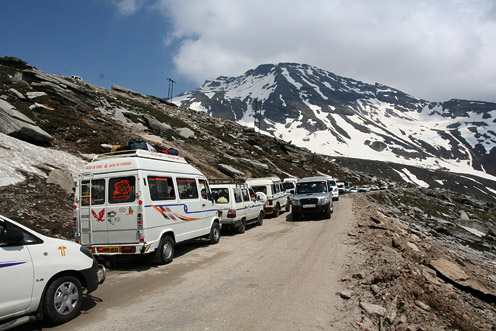
The road to Rohtang Pass (File Photo)
The last hour of the journey though, is much more than the romance with the mountain ranges. The rush of tourists in search of snow creates frequent traffic jams on the way up. Unmetalled surface can be slushy and hard to navigate. The thin mountain air and the half burnt diesel emissions from the pile of vehicle heading up is not exactly pleasant. It looks no different from peak hour traffic in congested roads of our cities, save for the views of the mountains here.
Tourists at Rohtang Pass (File Photo)
In summer months when there is still snow, Rohtang attracts large crowds excited about the snow. It’s a mad tourist trap that takes in thousands of people, followed by hundreds of vendors trying to keep the tourists comfortable and happy. The plateau on the pass turns into a big market place with long lines of shacks selling things from Aloo Paratha to skiing lessons. But later in the season when the slopes are bare (this is when the Ladakh season begins, in late June), there are just a handful of optimistic tourists searching for last of the snow.
Beyond Rohtang: Chandra Valley in Lahaul (File Photo)
However, there is a sea change in atmosphere on getting past Rohtang and entering into the valley of Chandra river in Lahaul region. The greenery that kept comapny disappears suddenly and the slopes appear brown and arid. Dhauladhar mountains (the mountain range that hosts Rohtang Pass) keep the monsoon at bay, allowing little precipitation and extending the summer days until October. The mass of tourists, the traffic and commotion dies down and makes way to silence. Verdant landscapes of Beas Valley make way to a stark beauty that has no parallels to scenery witnessed so far. It is here that the traveller begins to see first glimpses of barren landscape that Ladakh is, though Ladakh itself is still far away.
We waited at Manali’s bus station, reluctantly taking one of the grimy seats for lack of better options. We were planning to be at Keylong that evening, stopping for a few days on our way to Leh. We only knew that Keylong is going to be our next stop, but had not taken the trouble to plan how long. After Keylong, we would just hop to the next place we would feel like staying at. It could be Sarchu, Pang or any other lone parachute tented hamlet on the long road across the Himalayas.
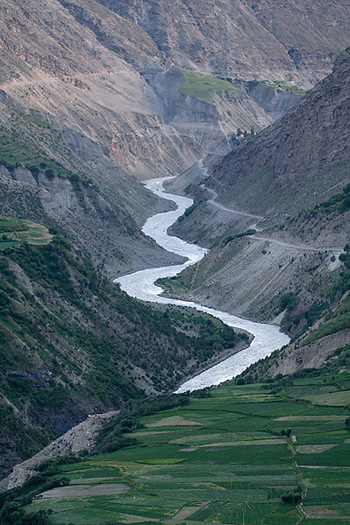
Bhaga River Valley at Keylong. To the right of the valley is the road we took to Keylong.
Keylong is one of the major towns across Rohtang Pass and is the district headquarters of Lahaul. Manali happens to be a tourist hub and the gateway to further north. We took it for granted that there will be many buses linking the two. Bad thinking! The 10am bus had left Manali fully loaded a little before we got to the bus stop. The next bus would arrive only at 2pm and it was likely to run full too. The grimy seat at the bus stand was going to be our associate for longer than we wished for.
A few inquiries for alternate transport resulted in the obvious suggestion – hire a taxi. We did not want a cab for ourselves and there were no shared taxis heading to Keylong. A few people waited along with us, looking for a faster way to get to Keylong. In an hour or so, one of them came back with a good news – there was Tata Sumo heading towards Keyong.
The driver of the Sumo was a young boy, probably in early twenties. He thought for a while when we asked him for two seats. He had to calculate the tourist rate by assessing our clothes, the manner of speech and then guessing the depth of our pockets. After a pause of few seconds, the premium on our seats was set at Rs.50 above the price quoted for the rest. But I knew what the others were paying, which made negotiating easy. We agreed to pay a premium of Rs.25 and bargained for the best seats at the front in return. We were ushered into the Sumo, and I expected to get going in a few minutes, heading out of Manali towards the mountains with five figure altitudes.
It turned out I was wrong. Filling up rest of the seats in the Sumo took more than an hour’s work. In fact, while the driver went around in search of passengers, a few who were already in the jeep went away, tired of waiting. The vacated seats prolonged our wait but thankfully it did not result in a chain reaction. When we finally left, we had just 30 minutes lead time from the 2pm bus.
The journey was a breeze once we took off. In the next two hours, we climbed up Rohtang pass and got down to Chandra Valley, stopping at Khoksar Village for a break. It was just after sunset when we arrived at Keylong, and all that was left to do was to find a place to stay and rest for the night. It turned out to be a job not as simple as it seemed to be.




